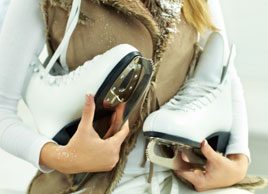The fitness benefits of ice skating
No doubt about it, zooming around on the ice’whether indoors or out’is a fantastic way to embrace winter and get some exercise at the same time

Source: Best Health Magazine, January/February 2012
The fitness benefits
Ice-skating is easy on the joints because it’s low impact, and it improves your balance and coordination. ‘You use a lot of small stabilizer muscles that don’t get a workout in day-to-day life, in particular those around your hips, knees and ankles,’ says Kristin Kunze, a certified skating coach and coordinator of the skating programs in the faculty of kinesiology at the University of Calgary. ‘Strengthening those small muscles helps you in other activities, like running, skiing and yoga.’ You’re also toning larger muscles in your legs, butt and core as you propel yourself on the ice. ‘You never see a skater with a flabby bum!’ Kunze notes.
The calorie burn depends on your speed: A 155-lb. woman skating slowly (less than 14 kilometres per hour) burns about 387 calories per hour. Fast, full-out skating (for example, chasing a puck) burns 633 calories per hour. Kunze adds that skating outside offers a bit more of a workout than an indoor rink since you’re contending with wind and bumpier, harder ice.
The most common injuries are to the wrist, or those that come from falling backwards onto the ice and hitting your tailbone or the back of your head. Says Kunze: ‘If you’re skating stiffly, and flail your arms backwards when you lose your balance, you’ll end up on your butt. You need to bend your knees a bit to gain more control, so that you’ll fall on your side.’
What to wear
Warm, light layers work well no matter where you skate. Buying skates, rather than borrowing or renting, is best because your feet will be fitted properly and you’ll be more comfortable (see box, above right). A helmet is a great idea, and it’s generally mandatory for skating lessons; you will need either a hockey helmet or a multi-purpose winter sports helmet such as one used for skiing or snowboarding.
Take lessons
If you’re a beginner or just want to brush up your skills, take adult skating lessons. They generally cost about $75 and up for group lessons, and run for six to eight weeks. Look for classes that are 45 minutes to an hour long, with at least one teacher to every eight students, suggests Kunze.
In a basic class, you’ll learn skills such as how to stand, fall down, get up, stop and glide. In an intermediate class, you may learn about crossovers or power skating.
Speed-skating classes are becoming more popular, too, perhaps due to gaining a higher profile at the 2010 Olympics in Vancouver. Speed skates are an expensive specialty option, so contact a speed-skating club for advice on where to try these skates.
Stay safe on outdoor ice
The Canada Safety Council recommends some basic guidelines if you’re skating on a lake or river:
‘ Use designated areas maintained by people who are knowledgeable about the local conditions such as currents and water depth, which can affect ice thickness.
‘ Remember that river ice is frequently unstable due to changing currents.
‘ Ice must be at least four inches (10 cm) thick. Clear blue ice is strongest; grey ice is unsafe.
Get the right fit
Ditch those figure skates you wore in high school. Skates are much comfier now, with new materials such as carbon fibres and lightweight plastics. ‘I recommend hockey skates for recreational skaters because you can get a decent pair from companies like Nike, Bauer, Graf or Easton for about $100,’ says Kunze. Go to a specialized sporting goods store so you’ll get a sales clerk who knows how to choose the best pair for your feet and ability.
In general:
‘ Skates are usually a size smaller than your normal shoe size.
‘ Wear thin wool or fitness socks rather than doubling up with two pairs of
regular socks.
‘ Lace the skates firmly and stand up. Your heel should be right at the back of the boot, and your toe should not touch the front end. Your heel and ankle should feel snugly gripped, as if you’re wearing running shoes, but not tight or painful.
‘ Get the store or your local rink to sharpen the skates before you hit the ice. If you’re skating leisurely once a week indoors, sharpening once a winter is fine. Outdoor ice contains grit and mineralized water and is harder on your blades, so sharpen every outing or two.
This article was originally titled "Lace ’em up!" in the January/February 2012 issue of Best Health. Subscribe today to get the full Best Health experience’and never miss an issue!




